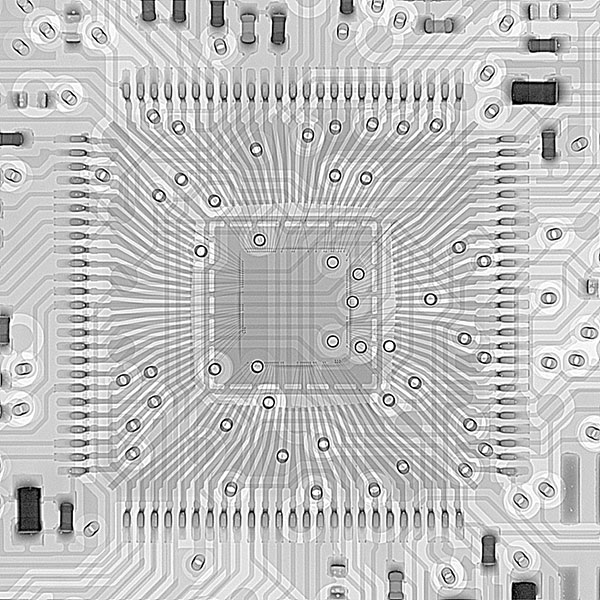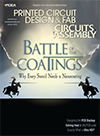Features Articles
 Accommodating for warped boards.
Accommodating for warped boards.
The current consumer electronics manufacturing climate, which dictates thinner boards and stencils, component placements right to the very edge and panelized assemblies with a significant amount of routing, makes it increasingly challenging to ensure board flatness and coplanarity for a good stencil printing outcome. But, as you know from reading this column regularly, one fact is nonnegotiable: Good printing results require a tight stencil-to-board gasket across the whole of the panel. (See “For Successful Printing, Don’t Blow the Gasket,” October 2018.) This requires the PCB to be flat.
Board warpage – or bow and twist, as I like to refer to it – has always been a key consideration for stencil printing. However, in the past, the 2mm-thick boards being processed were more likely to arrive from the fabricator flat and remain that way through topside printing, reflow and bottom-side printing. The occasional bowed panel was easy to rectify with over-the-top clamps and a good tooling vacuum. Today, however, as consumer PCBs have become thinner, with more routing (interspace) around the supporting panel, warpage is a far more common and vexing issue. Smaller, higher-functioning consumer products have moved us toward 0.6mm-thick boards and stencils as thin as 80µm (and thinner). This combination of factors is making PCB bow and twist increasingly likely and its traditional remedy less than ideal in isolation. Any interspace created during the printing process introduces the opportunity for defects not only with board-to-board repeatability, but also within the panelized PCB from corner-to-corner and side-to-side.
 Keep talking – your customer is listening.
Keep talking – your customer is listening.
If I were to list deadly sins in sales, at the top would be failure to stay in touch with good prospects who are not yet ready to buy. The top deadly sin in program management is failure to stay abreast of what challenges are keeping customers up at night.
In both situations, the outcome is a sale goes to the company keeping a better tab on what that prospect or customer needs. It drives home the need for what I call mindshare maintenance. Mindshare maintenance involves regular contact with prospects and customers to remind them you are out there. When it involves prospects in the sales pipeline, it can be a periodic phone call, a link to an article or white paper the prospect might consider relevant, or a free pass to a trade show in the prospect’s region. The goal is to find a way to share useful information and remind that prospect your company is available, if they are getting ready to outsource. The benefit of doing it at regular intervals is it eventually catches companies just as they enter the ready-to-buy stage.
 The pursuit of a vision, such as a driver-free car, has invaluable benefits.
The pursuit of a vision, such as a driver-free car, has invaluable benefits.
Technology development has been on a tear in the global automotive sector, an industry that could be leading all others in the development of sophisticated electronics. Event after event, the globe has been laser-focused on developments, trials and efforts underway in transportation to make this newly developed technology robust and ruggedized to operate – safely – in the varied and harsh environments automobiles operate. Virtually every system has been redesigned, with electronics and electronic sensors displacing electromechanical and mechanical components. The automobile of today is safer, quicker and more fuel-efficient than was imaginable even a decade back.
In the auto’s transition from a “hunk of bolts” to “elegant high-tech machine,” no aspect has sparked the imagination of engineers, or the greed of investors, more than the development and commercialization of the autonomous vehicle. On one level, I am amazed we are on the verge of harnessing an array of technology that could more safely transport people and cargo than a skilled, experienced driver. But on a different level, I am highly skeptical of the commercial viability of autonomous vehicles. This skepticism is rooted in a simple question: Who really wants an autonomous vehicle?
Head-on-pillow and head-in-pillow look different under x-ray. The distinction is important.
 Void size and location can predict future failures.
Void size and location can predict future failures.
Perhaps quad flat packages are not as fashionable a package choice as they once were because of their limited I/Os compared to BGAs, but they continue to be a staple in electronics (FIGURE 1). As such, they are still a source of problems to assemblers. With their typical gull wing joint style, located on the outside of the package rather than beneath it, these devices can be inspected optically. This can identify some issues that may arise but, as with other packages, if you can’t see the problem optically, it does not mean it is not there! Therefore, x-ray inspection of QFPs can complement any optical inspection, not only by helping confirm issues raised optically, but also providing wider fault coverage through identifying and helping mitigate a range of optically invisible issues that QFPs can provide.

Figure 1. X-ray image of QFP from the top down.
 Solder paste escaping gaps in underfill can cause electrical failures.
Solder paste escaping gaps in underfill can cause electrical failures.
Welcome to our latest Defect of the Month. This month we illustrate what can happen with area array packages that have been underfilled during rework.
During any rework, it is important to avoid overheating components on the opposite side of the board or adjacent to the parts being reworked. If solder joints surrounded by underfill undergo reflow, or are close to reflow temperatures, the solder will expand/extrude, then flow under pressure through any openings (FIGURE 1). (We have captured solder reflow in underfill during reflow simulation in x-ray investigations for a customer at Dage.) Voids in the underfill or gaps caused by expansion of the component can result in joints becoming intermittent. Such joints can fail at any time during the product’s life.
Press Releases
- 2026 IEEE Electronic Components and Technology Conference Student Innovation Challenge Pre-registration Deadline Extended to January 11, 2026
- PCBsync PCB Assembly Introduces Full-Scale Electronic Manufacturing Service
- Magic Leap Partners with Pegatron for AR Glasses Components Production
- TEXMAC/Takaya Appoints ARK Mfg. as New Rep in Arizona


